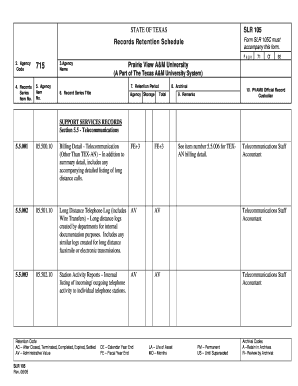
Records Retention Schedule Example Form


What is the records retention schedule example
A records retention schedule example outlines the specific time frames for retaining and disposing of various types of records within an organization. This schedule helps ensure compliance with legal and regulatory requirements while promoting efficient records management practices. Typically, it categorizes records by type, such as financial documents, employee records, and operational files, and specifies how long each type should be kept before disposal. Understanding this example is crucial for businesses to maintain proper documentation and avoid potential legal issues.
How to use the records retention schedule example
Utilizing a records retention schedule example involves several steps. First, assess the types of records your organization generates and categorize them according to their function and importance. Next, refer to the retention schedule example to determine the appropriate retention period for each category. It is essential to regularly review and update the schedule to reflect any changes in laws or business practices. Finally, ensure that all employees are aware of the schedule and trained in its application to maintain compliance and efficiency.
Key elements of the records retention schedule example
Key elements of a records retention schedule example include:
- Record Type: A description of the type of record, such as invoices, contracts, or employee files.
- Retention Period: The length of time the record must be kept, which can range from a few months to several years.
- Disposal Method: Guidelines on how to securely dispose of records once the retention period has expired, such as shredding or electronic deletion.
- Legal Compliance: References to relevant laws and regulations that govern record retention for specific types of documents.
Steps to complete the records retention schedule example
Completing a records retention schedule example involves a systematic approach:
- Identify Records: List all types of records your organization generates.
- Determine Retention Periods: Consult legal guidelines and best practices to assign retention periods for each record type.
- Document Disposal Methods: Specify how records will be disposed of after the retention period.
- Review and Update: Regularly review the schedule to ensure it remains compliant with current laws and organizational needs.
Legal use of the records retention schedule example
The legal use of a records retention schedule example is vital for compliance with federal and state regulations. Organizations must adhere to laws such as the Sarbanes-Oxley Act, which mandates specific retention periods for financial records, and HIPAA, which governs the retention of health-related information. By following the guidelines outlined in a records retention schedule, businesses can protect themselves from potential legal repercussions associated with improper record management.
Examples of using the records retention schedule example
Examples of using a records retention schedule example can vary by industry. For instance, a healthcare provider may retain patient records for a minimum of six years after the last treatment date, while a financial institution might keep transaction records for at least seven years to comply with IRS guidelines. Each example illustrates the importance of tailoring the retention schedule to meet specific industry requirements while ensuring efficient records management practices.
Quick guide on how to complete retention schedule template
Easily Prepare retention schedule template on Any Device
Managing documents online has become increasingly popular among businesses and individuals. It offers an ideal environmentally friendly alternative to traditional printed and signed documents, allowing you to obtain the proper form and securely keep it online. airSlate SignNow equips you with all the tools necessary to create, edit, and electronically sign your documents quickly and efficiently. Handle records retention schedule example on any device using airSlate SignNow's Android or iOS applications and enhance any document-related workflow today.
How to Edit and Electronically Sign records retention schedule template Effortlessly
- Find record retention schedule template and click Get Form to begin.
- Utilize the tools we provide to complete your document.
- Emphasize important sections of the documents or redact confidential information with tools specifically offered by airSlate SignNow for this purpose.
- Create your electronic signature using the Sign tool, which takes just seconds and carries the same legal validity as a conventional wet ink signature.
- Review all the details and click on the Done button to save your modifications.
- Select how you want to send your form—via email, text message (SMS), invitation link, or download it to your computer.
Say goodbye to lost or misfiled documents, tedious form searches, or mistakes that necessitate printing new document copies. airSlate SignNow fulfills all your document management needs in just a few clicks from your chosen device. Modify and electronically sign document retention schedule template to ensure effective communication throughout your form preparation journey with airSlate SignNow.
Create this form in 5 minutes or less
Related searches to records retention schedule pdf
Create this form in 5 minutes!
How to create an eSignature for the records management retention schedule template
How to create an electronic signature for a PDF online
How to create an electronic signature for a PDF in Google Chrome
How to create an e-signature for signing PDFs in Gmail
How to create an e-signature right from your smartphone
How to create an e-signature for a PDF on iOS
How to create an e-signature for a PDF on Android
People also ask retention schedule
-
What is a records retention schedule example?
A records retention schedule example outlines how long specific types of documents should be kept before they can be discarded. This schedule is essential for compliance with legal and regulatory requirements, ensuring you retain important records while optimizing storage costs.
-
How can airSlate SignNow help with records retention schedules?
airSlate SignNow provides tools that simplify the creation and management of records retention schedules. By integrating document eSigning and storage, businesses can easily access and track their records retention schedule examples to ensure compliance and streamline their document workflows.
-
Is there a cost associated with using airSlate SignNow for records retention?
Yes, airSlate SignNow offers various pricing plans tailored to different business needs. In each plan, you’ll find features that assist in creating a records retention schedule example, making it an affordable option for businesses of all sizes seeking effective document management.
-
What features does airSlate SignNow include that facilitate records retention?
airSlate SignNow includes features like automated notifications for document expiry, easy document templates, and eSigning capabilities, all of which are essential for maintaining an efficient records retention schedule example. These features ensure your business remains compliant while minimizing manual tasks.
-
Can I customize my records retention schedule example with airSlate SignNow?
Absolutely! airSlate SignNow allows for customization of your records retention schedule example based on your specific business needs and legal requirements. This flexibility ensures that your document management aligns with your organizational policies.
-
Does airSlate SignNow integrate with other software for records management?
Yes, airSlate SignNow seamlessly integrates with various third-party applications, enhancing your records management capabilities. These integrations can streamline the implementation of your records retention schedule example within existing workflows, improving overall efficiency.
-
What are the benefits of using airSlate SignNow for managing records retention schedules?
Using airSlate SignNow for managing records retention schedules offers numerous benefits, including increased compliance, reduced operational risk, and improved document access. The platform's ease of use and robust features make it an ideal solution for streamlining your records retention schedule example.
Get more for records retention schedule
- Form np 659 007 ampquotnotary public commission application
- Notary public appointmentreappointment application please read carefully and follow all instructions exactly form
- Office of career services the ohio state university moritz college of form
- Printable form jctc 01
- Arkansas paramedic reciprocity form
- Arkansas emt patch order form
- Flu shot administration form
- Ambulance refusal form
Find out other records retention schedule example
- Can I Sign North Carolina Orthodontists Presentation
- How Do I Sign Rhode Island Real Estate Form
- Can I Sign Vermont Real Estate Document
- How To Sign Wyoming Orthodontists Document
- Help Me With Sign Alabama Courts Form
- Help Me With Sign Virginia Police PPT
- How To Sign Colorado Courts Document
- Can I eSign Alabama Banking PPT
- How Can I eSign California Banking PDF
- How To eSign Hawaii Banking PDF
- How Can I eSign Hawaii Banking Document
- How Do I eSign Hawaii Banking Document
- How Do I eSign Hawaii Banking Document
- Help Me With eSign Hawaii Banking Document
- How To eSign Hawaii Banking Document
- Can I eSign Hawaii Banking Presentation
- Can I Sign Iowa Courts Form
- Help Me With eSign Montana Banking Form
- Can I Sign Kentucky Courts Document
- How To eSign New York Banking Word